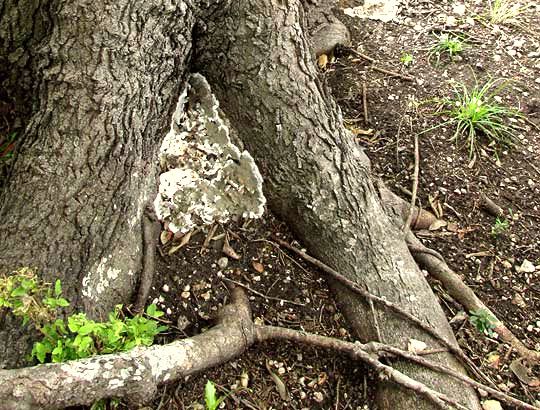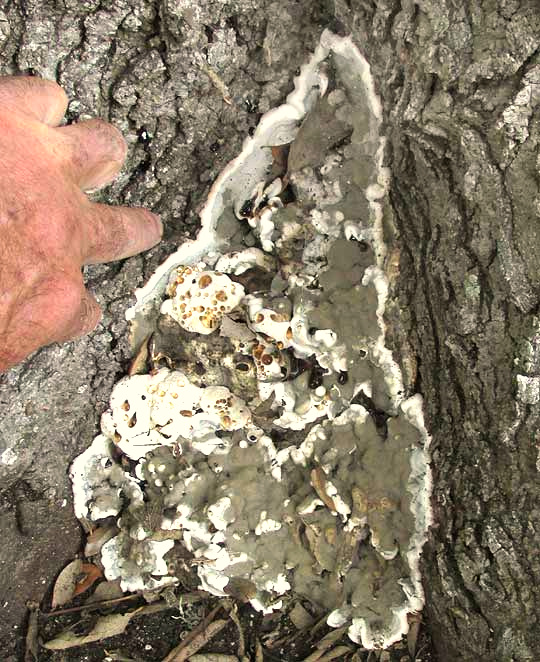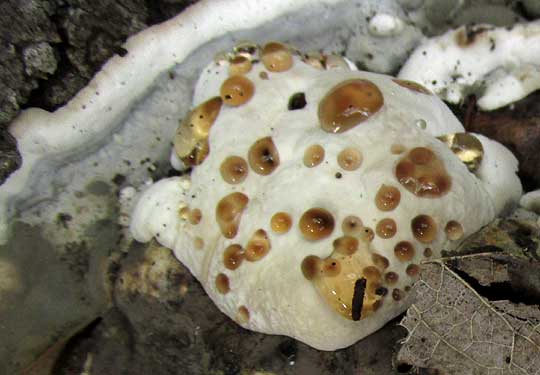Excerpts from Jim Conrad's
Naturalist Newsletter
from the September 28, 2014 Newsletter issued from the Frio Canyon Nature Education Center in the valley of the Dry Frio River in northern Uvalde County, southwestern Texas, on the southern border of the Edwards Plateau; elevation ~1750m (~5750 ft); N29.62°, W99.86°; USA
BRITTLE CINDER
Right beside a house I was painting, where two large roots converged at the base of a trunk of a thriving Texas Live Oak, Quercus fusiformis, there was a fungus the size of a dinner plate I'd never seen before. It's shown below:

This is not a typical mushroom with a stem, or even a shelf-type fungus sticking from the trunk like a horizontal ear, but rather it's formed as a crust, with the fungus's bottom attached to its substrate. Most of it is attached to the trunk but notice just to the right of the trunk, at the picture's very top, there's a whitish colony on organic-matter-rich soil. In fact, smaller populations occurred all around the trunk, sometimes on wood, sometimes on the ground, sometimes looking as it little groupings had been splattered there messily. Up close the large body shows more peculiarities, as shown below:

It's a crust with a mostly gray surface but white along the edges where new growth extends its size, and white in the center area where cauliflower-like growths arise. And on some of the white central cauliflowers there are amber-colored drops of liquid, shown closer up below:

Assuming that these might be dewdrops or drops of sap from the tree, I almost didn't photograph them, but then I remembered that here we seldom get dew and drops of sap weren't visible elsewhere, so I took the picture, and I'm glad, since now I know that they constitute an important field mark. In the centers of the bases of many of the droplets in that picture you can see pinprick-like holes. I'm guessing that they're wormholes from which juices inside the fungus have exuded. The next day, the sap had turned almost black.
One last picture showing the white fungus border extending up a limestone rock on the ground is shown below:

Having never encountered a crust fungus like this I hardly knew where to begin the identification process. I settled on the not-so-technical approach of doing a Google image-search on the keywords "fungus crust oak." Almost instantly a thumbnail popped up showing something similar to our find under the heading "Bleeding Oak Crust Fungus."
*UPDATE: This lead turned out to be a false one. Bleeding Oak Crust Fungus is a species of the catch-all, poorly understood genus Stereum, and I filed this page under that name. However, in 2024 I uploaded the above pictures to the iNaturalst website, where after a few weeks user "tombigelow" recognized the fungus as a member of the genus Kretzschmaria. The GBIF database reported that genus as occurring in our part of Texas, and the only species documented here was KRETZSCHMARIA DEUSTA, pictures of which matched ours.
Kretzschmaria deusta occurs nearly worldwide, but mainly in the northern Temperate Zone. Our individual appears to be at the very southwestern extreme of its eastern North America distribution. It attacks living hardwood trees of numerous species, from maples to hackberries, and beech to oaks. It's thought to be a heart-rot pathogen, entering healthy trees through injuries to lower stems and/or roots. It begins as a soft rot, and the disease continues until the tree is dead.
Kretzschmaria deusta was the September, 2023 "Mushroom of the Month" for the Central Texas Mycology organization. This recognition was given because, as the organization's web site for the page explains, "You may have heard about it recently in the news, as one of Austin’s beloved pecan trees Flo, a centurion living on the banks of Barton Springs pool, has been diagnosed with this deadly fungus."